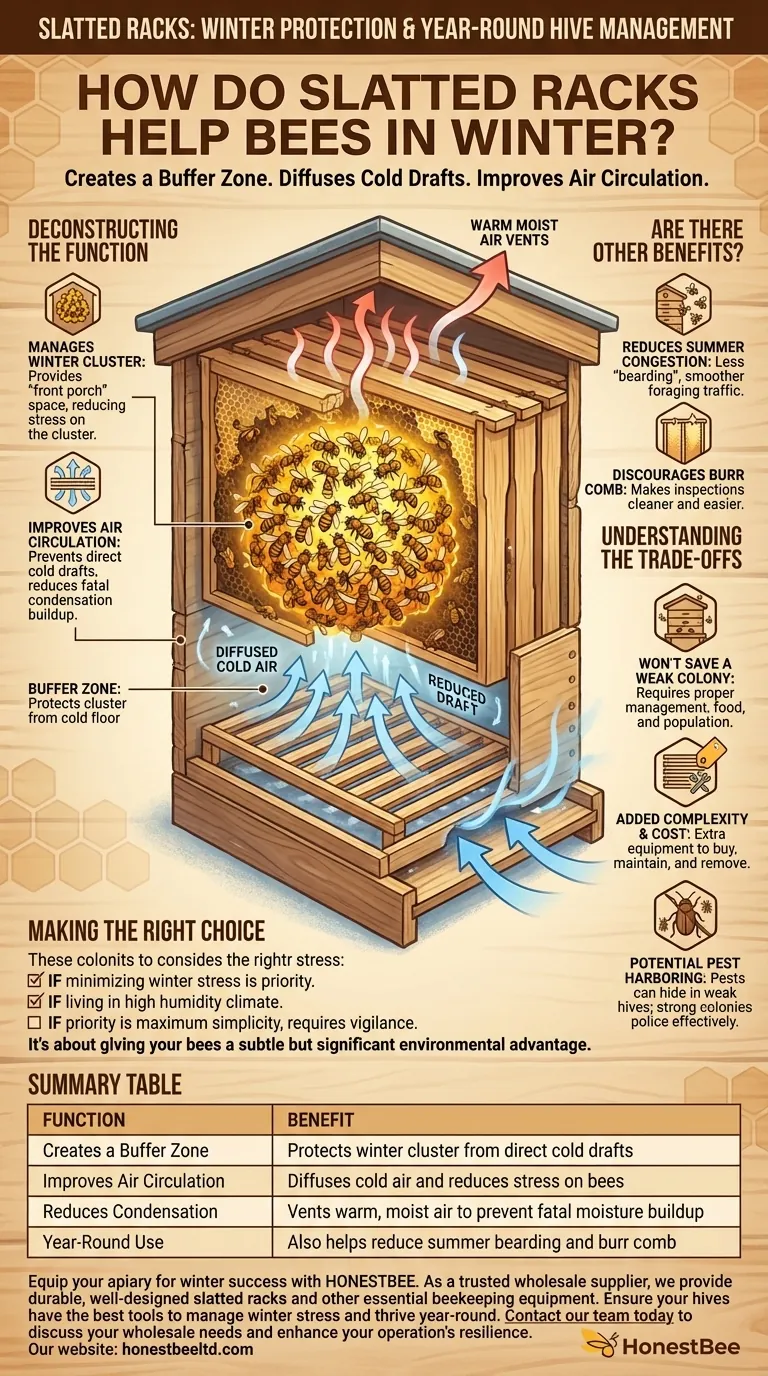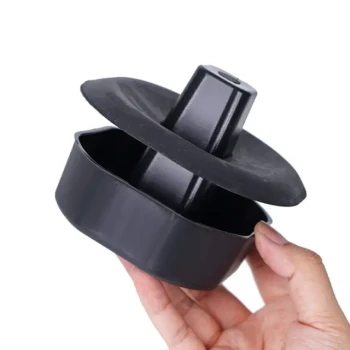In practice, a slatted rack helps bees in winter by creating a buffer zone that manages air circulation and provides space for the bee cluster, rather than by acting as simple insulation. It diffuses cold drafts from the entrance and gives the cluster a "front porch" area, reducing direct exposure to the cold and improving the overall hive environment.
A slatted rack is not a magic insulator that keeps a hive "toasty." Its true value lies in improving ventilation and providing crucial transitional space below the brood nest, which reduces stress on the winter bee cluster.

Deconstructing the Slatted Rack's Function
A slatted rack is a simple wooden frame, about two inches high, with slats that run parallel to the hive entrance. It is placed directly on the bottom board, and the first brood box sits on top of it. Its design seems simple, but its impact is based on subtle environmental management.
How It Manages the Winter Cluster
The most critical task for bees in winter is forming a winter cluster to generate and conserve heat. A slatted rack directly aids this process.
It provides an empty "buffer" space between the cold bottom board and the bottom of the frames. This means the bee cluster doesn't have to form directly against the floor or in the immediate path of cold air entering the hive. This space allows the cluster to move and contract without being subjected to the harshest drafts.
How It Improves Air Circulation
A common misconception is that a slatted rack works by creating "dead air space" for insulation. Its primary benefit is actually related to air movement.
Cold air entering the hive entrance is diffused as it flows up through the slats. This prevents a concentrated, direct draft from hitting the cluster. Instead of a single jet of cold air, you get gentler, more distributed circulation, which is far less stressful for the bees.
This improved circulation also helps vent the warm, moist air produced by the bees. Reducing condensation buildup inside the hive is one of the most important factors in successful overwintering, as cold moisture dripping on the cluster can be fatal.
Are There Other Benefits?
While its winter advantages are significant, a slatted rack is a year-round tool that helps with general hive management.
Reducing Summer Congestion
In hot weather, a slatted rack provides extra space near the entrance. This helps reduce "bearding," where large numbers of bees congregate on the outside of the hive to cool off, and keeps foraging traffic flowing smoothly.
Discouraging Burr Comb
The rack creates a gap that discourages bees from building burr comb and drone brood between the bottom bars of the frames and the bottom board, making hive inspections cleaner and easier.
Understanding the Trade-offs
A slatted rack is a valuable tool, but it is not a cure-all and comes with considerations.
It Won't Save a Weak Colony
A slatted rack can help a healthy colony thrive, but it cannot compensate for low population, disease, or insufficient food stores. Proper management is always the most important factor.
Added Complexity and Cost
It is one more piece of equipment to buy, maintain, and remove during hive inspections. For beekeepers focused on absolute simplicity, this can be a drawback.
Potential Pest Harboring
In a weak hive, the space within the slatted rack can become a hiding place for pests like small hive beetles or wax moths. A strong, populous colony will typically police this area effectively.
Making the Right Choice for Your Hives
Ultimately, the decision to use a slatted rack depends on your beekeeping goals and local climate.
- If your primary focus is minimizing winter stress: A slatted rack is a highly effective tool for managing drafts and improving the cluster's environment.
- If you live in a climate with high humidity: The ventilation benefits for reducing deadly winter condensation are a compelling reason to use one.
- If your priority is maximum simplicity and minimum cost: You can successfully overwinter bees without one, but you must remain vigilant about providing proper ventilation through other means.
Using a slatted rack is about giving your bees a subtle but significant environmental advantage to better manage the rigors of winter.
Summary Table:
| Function | Benefit |
|---|---|
| Creates a Buffer Zone | Protects the winter cluster from direct cold drafts |
| Improves Air Circulation | Diffuses cold air and reduces stress on bees |
| Reduces Condensation | Vents warm, moist air to prevent fatal moisture buildup |
| Year-Round Use | Also helps reduce summer bearding and burr comb |
Equip your apiary for winter success with HONESTBEE. As a trusted wholesale supplier for commercial apiaries and distributors, we provide durable, well-designed slatted racks and other essential beekeeping equipment. Ensure your hives have the best tools to manage winter stress and thrive year-round. Contact our team today to discuss your wholesale needs and enhance your operation's resilience.
Visual Guide

Related Products
- Langstroth Screen Bottom Board for Beekeeping Wholesale
- Langstroth Solid Bottom Board for Beekeeping
- Professional Insulated Winter Hive Wrap for Beekeeping
- Professional Galvanized Hive Strap with Secure Locking Buckle for Beekeeping
- In-Hive Dual Compartment Frame Bee Feeder for Targeted Colony Nutrition
People Also Ask
- How does a screened bottom board assist with temperature control and pest management? A Key Tool for Modern Beekeeping
- What are the benefits of a screened bottom board? Boost Hive Health & Control Varroa Mites
- What is the primary function of a screened bottom board in a hive? Enhance Ventilation & Control Varroa Mites
- What are the benefits of using a screened bottom board for beehives? Improve Ventilation & Mite Control
- What are the assembly options for the Cypress Screened Bottom Board? Ready-to-Use for Immediate Hive Health



















